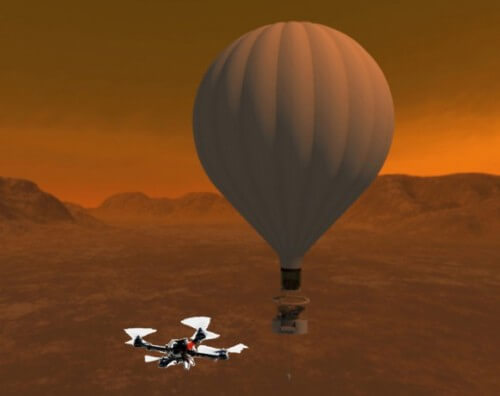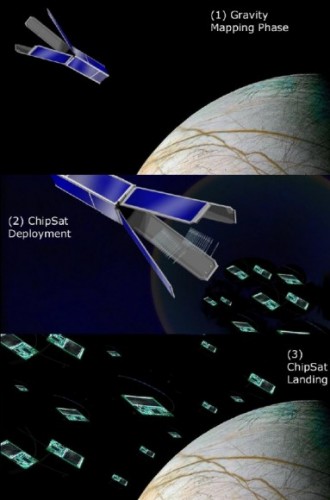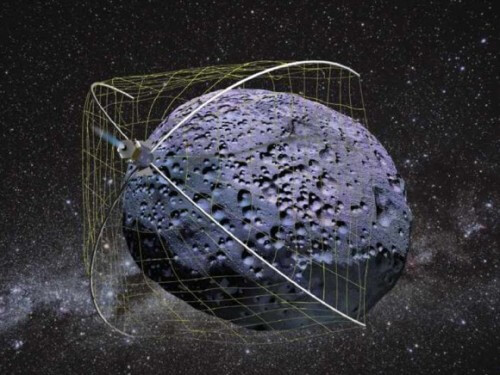This is evident from a number of long-term projects that NASA has chosen to finance, for missions that will fly, if at all, in the thirties or forties of the 21st century

Sometimes a good idea needs time to cook properly. You have a feeling that the idea will work, but what you really have to do is invest money and time and check if the idea really works as expected on a small model. This suggestion makes sense if we are trying to do a home renovation (applying a small strip of paint on the wall will allow you to check if the color suits you) and even more so if we are planning a multi-million dollar reconnaissance mission to another planet.
This is the basis of the vision of NASA's 'Office of Advanced and Innovative Ideas', which has announced a dozen research proposals that have been approved for initial funding of $100,000 each over the coming year (for the research proposals). Among the proposals - vehicles for exploring the moon Titan, a system for capturing an asteroid moving in space, and other ventures aimed at exploring the solar system. (At the same time, we must be extremely patient - it will take decades for these theoretical ideas to come to fruition, if at all they will pass the next stages of testing and funding). Below is a concise description of all the ventures that received initial funding.
An airborne probe to explore the moon Titan: A small rotary craft released from a hot air balloon or lander will land on the moon Titan. The idea is that this tool will be able to jump between several points on the surface of the moon in order to provide close-up pictures. In the next step, at the end of the tour, it will be able to return ground and air samples to the mother ship and also be recharged. "The autonomy required to realize this idea will also be applicable for existing missions of other rotary vehicles for the study of Mars and for the in-depth study of Enceladus (the sixth largest moon of Saturn)," the description of the proposal stated.

Submarine for the exploration of the moon Titan: A small submarine will dive into the Kraken Mare lake located on Saturn's moon Titan, where there is much to explore: it is a lake 300 meters deep and 1000 km wide. "The Kraken Mare lake is similar in its area to the cumulative area of the Great Lakes [Great Lakes, a group of seas located in North America and constitute the largest marine system in the world] and it presents a golden opportunity for a planetary exploration mission unprecedented in its scope," the description of the proposal stated. The mission will examine "the chemical composition of the liquid that makes up the sea, the currents above and below the front of the liquid, the mixing and settling in the "water" column, the behavior of the tides, winds and waves, will measure the depth of the liquid, and will examine the characteristics and composition of the seabed."
Catch a ride on a comet: This idea describes a spacecraft that will swing from one comet to another in order to study icy bodies in the solar system. "In the first step, the spacecraft will 'hunt' with the help of 'ringing' its target while it flies close to the comet's surface in order to attach a rope to the target. In the next step, while the target is moving away, the spacecraft wraps the rope while applying renewed braking in order to give itself a moderate acceleration (<5g) and also to obtain self-energy," the description of the proposal stated.
Weightless rendezvous and net capture to limit asteroid over-rotation: A system called WRANGLER (Weightless Rendezvous And Net Grapple to Limit Excess Rotation) that aims to capture fragments of space debris in space as well as small asteroids. The system will use a nanosatellite equipped with a 'capture net device' and a winch. "The lever power provided by using a rope while utilizing the angular momentum of an object rotating in space allows a very small nanosatellite system to slow down the rotation of a very massive asteroid or a large spacecraft," the description of the proposal states.
The aragoscope: A telescope capable of looking at a distant object through a cloudy plate, one that differs from the arrangement of mirrors in a normal telescope. "Instead of blocking the viewing range, the desk improves the separation capacity of the system without harming the collection area," states the description of the proposal. "The architecture of the system can be used to achieve the diffraction limit on the basis of the area of the cheap disk, and not on the basis of the high cost of the mirrors in a normal telescope."
Experimental facility for Mars landing: a facility that will test the ability of bacteria originating from the Earth to survive on the planet Mars, a step that will precede the earthing of the planet As possible. Researchers will select 'pioneer creatures' and put them into a device that will fix itself into the regolith on the surface of Mars in an area where liquid water is found. "The facility will completely seal itself in order to prevent planetary contamination, will carefully release selected terrestrial organisms (extremophiles such as cyanobacteria strains), will sense the presence or absence of metabolic products (such as oxygen) and will transmit the data back to the Holiday satellite around Mars," the description of the proposal stated.
ChipSats: Instead of launching separate missions of the holiday spacecraft around the star/moon and lander, why not combine them together? Although there have already been such integrated missions (for example, Cassini/Higgins), the idea is slightly different: the new system will have a collection of tiny sensing chips (ChipSats) that will be launched from the mother spacecraft and land on distant planets or moons.
Gravimetry using proximity flying of swarms: Once the system detects an approaching comet or asteroid, a single spacecraft will trigger the release of a swarm of tiny sensors. "Through the measurements that these sensors will perform, we will be able to estimate the asteroid's gravitational field and learn about its chemical composition and structure," the description of the proposal stated.

Exploring ice worlds: What is the thickness of the ice layers on Jupiter's moons Europa and Ganymede, or Saturn's moon Enceladus? This is an open question that makes it difficult to estimate the depth that would have to be drilled in order to explore the ice - and the possibility of life existing in such places. The idea is to send a sensor to these places and receive back a "signal from a natural source created by the interaction with depth-penetrating neutrons originating from cosmic radiation", this in order to gain more insights regarding the various depths. The system will be able to provide mapping of the glaciers.
Heliopause Electrostatic Rapid Transit System (HERTS):: This is a mission that went deep into the solar system and out of the heliopause [the final frontier of the flu the wind of the sun, which is a stream of ionized subatomic particles, emitted fromThe sun in all directions and create a huge bubble called the heliosphere, which moves along with Solar System in interstellar space]. Without using a propellant, the spacecraft will use the particles of the solar wind to move into the depths of the solar system.
"The propulsion system consists of an array of electrically charged wires that spread over an area of 10 by 30 km around the space shuttle," the researchers explain.
XNUMXD photocatalytic air compressor: A new design that facilitates the production of oxygen inside a spacecraft, using high-energy radiation that is abundant in space, as claimed in the research proposal. "The combination of innovative photoelectrochemistry together with a three-dimensional design enables a huge saving in mass, results in a reduction in hardware complexity and increases the flexibility and efficiency of deployment."
PERIapsis Subsurface Cave Optical Explorer (PERISCOPE): A method for mapping caves on the moon from space. Using a method known as "photon time-of-flight imaging", the researchers claim that they will be able to pick up the signals returned from caves and canyons after they have penetrated into the fissures and cracks and obtain an accurate mapping of these areas.

19 תגובות
of genius! Both an ecological solution and with minimal investment!
Lorem Ipsum
You wrote "huge companies are not able to dare and develop a profitable supersonic passenger plane (although it will pay off for those who manage to do it in a crazy way)".
Huge companies dare to do amazing things. They invest billions in all kinds of projects, quite a few of which have failed.
In your quote, in parentheses, you write that it will pay off like crazy. What I said is that you are wrong. 1 - It won't pay off (this is my opinion based on my background in the aviation world). 2 - The giant companies think it won't pay off, otherwise they would invest in this area.
Miracles,
I'm glad to see that you insist that companies make something that is purely profitable. If so, maybe you could explain to me where you claim my mistake is when I claimed that commercial companies would not develop exotic and (almost) disposable vehicles for exploring distant planets? And it doesn't matter if it's submarines for Titan, or a light-than-air helicopter carrier for Titan (the article talks about both), or any of the other exotic tools? Government bodies will have to make the offer the most profitable for the private sector so that it will be willing to develop something of this kind.
Lorem Epsom
I think your logic is a bit backwards. You said "useful and profitable". Useful is not a concept in economics. In the economy there is only profitable. And what I'm saying is that the reason companies don't develop what you wanted is precisely because it doesn't pay. Supersonic executive jets it pays off. Large supersonic airliners, not profitable.
Lorem Epsom
As for the Titan helicopter carrier in your answer to the miracles, this is not true. From my knowledge of the subject, the intention is to develop a submarine that will dive into one of its methane lakes. You probably didn't do your homework when you wrote your comment.
Lorem Ipsum
For your information, several years ago we built Bagbaj's computer from raw materials that were available in his time and the computer worked. So why did Babbage Lett build the computer? A prosaic reason. Completely. He ran out of money and if Bal or his competitor has the money? Think about it . This computer could work up to 15 places after the dot. The history of this case is probably not that familiar to you.
Regarding "technological developments happen when the time comes" you sound deterministic. The madman on duty will always arrive. He doesn't come up with an invention or a discovery straight off the cuff. He works hard for it. He just thinks differently, outside the box. Does the name Drexler mean anything to you? No clue. If you consider yourself an intelligent person and a great scientist (which I'm not so sure) give an answer to the question?
Nissim, if you carefully read my argument in the first message, you will see that I am arguing that if huge companies (or even small ones) in the private sector do not find justification (as you say) to develop something much more useful and profitable, why would they find justification to develop entirely esoteric research tools, such as a carrier Helicopters to Titan? To date no one has blocked them, yet I have yet to hear of any research tool belonging to a private company that has reached another planet.
Cheers, I understand that you sullenly retreat to the corner until the romantic genius comes along who will pull some amazing technology straight out of the box and present it to the admiring crowd. so no. Technological developments occur when the time is right and when science is advanced enough. If *Abraham* Graham Bell had not invented the telephone, his competitor would have, who filed his patent a day late. At most, the realization of the technology would be delayed by a few years. The genius Babbage was unable to put his calculating machine on a commercial basis because the technology was immature, and because he needed additional mathematical developments that came with Turing. Once Tyring arrived, such a machine could be realized, with any available technology that was powerful enough: electromechanical relays, vacuum tubes, crude transistors, integrated circuits and what not. (And let's not even start talking about Leonardo da Vinci, who was unable to realize almost any of his far-reaching visions).
Lorem Ipsum
Be precise in what I said - there is no economic justification for large supersonic passenger planes. Today, fuel is the main component of the cost of the flight. Supersonic planes will always consume more fuel (physics...). Therefore, flight prices will rise and most people will not buy these flights. The amount of business people on a flight is equivalent to an executive plane, and it is really in the field of these planes that research is invested.
Anyway, that's what I know.
Lorem Ipsum
I understand that you do not have too much understanding on the subject. Private companies invest where they see the ability to make a profit - that's their job. Governments support these initiatives where necessary - this is their role.
Lorem Ipsum
You never know what the next technological breakthrough will be. There will always be the crazy ones who come up with ideas that no one has thought of. Examples? The electrical genius Tesla, the Wright brothers and here in Israel the Nobel Prize winner Dan Shechtman, who for years was laughed at for his idea of crystal quasi. Never, and I repeat never, will there be those who find commercial uses for these ideas. What would you be doing today if Daniel Graham Bell had not developed the telephone. You would most likely use postal mail. Do you know who developed the first computer even though it was mechanical? The mathematician Babbage in the 19th century. Your conservatism and that of many others can boggle the mind.
Virgin Galactic also receives funding from Qatari sources. For these space ventures, even if they don't fulfill the vision. After all, they hold patents.
Lockheed Martin's plane is being developed in partnership with NASA, which means government money, and lots of it. The Japanese government agency is also working in collaboration with NASA. All the rest are what are called in Hebrew "executive planes" (ie - a toy for billionaires). Not commercial airliners capable of changing the face of civil mass aviation.
They do live, but it seems that they will become subcontractors of space agencies. The economy is not separated from politics. If they do not receive government incentives, they will not progress.
Lorem Ipsum
There are several companies that are developing supersonic aircraft for civil transport today. Companies like Irion, Spike, Lockheed Martin, Heifermach and Gulfstream for example. In addition, there are also Russian and Japanese companies that are trying.
So why just slander? 🙂
Huge companies are not able to dare and develop a profitable supersonic passenger plane (although it will pay off for those who manage to do it in a crazy way). That they will develop esoteric tools such as submarines for Titan, bungee devices for comets and lighter-than-air (autonomous) helicopter carriers (also autonomous) (also for Titan)?
You made me laugh.
Barak Molinov
The private sector has already entered the field of space. The example of the small ferry Dream Chaiser is all of the private sector. Those who designed and manufacture this ferry did not receive a single cent from the government. Everyone who deals with it treats the space as an investment that will pay for itself
When alive, says private sector. Is Elon Musk a private sector? In my opinion, not because he receives a budget from NASA. Only in the event that there is widespread use of satellites, and there is sure money, they are willing to invest.
My impression is that it will be done by the private sector. Beginnings There are already examples of the spacecraft that are supposed to replace the shuttles
Space and the interest these companies are beginning to discover in the Moon and Mars.
The Americans are a role model. But the management of their projects can be wasteful. (For example, the F35 was ordered without a model). In general, any criticism of America is received with hostility (accusation of communism). I believe that a situation should be reached, where they will not give the slanderers of Israel a platform, because there are also friends there. (for cooperation that is interpreted as espionage)